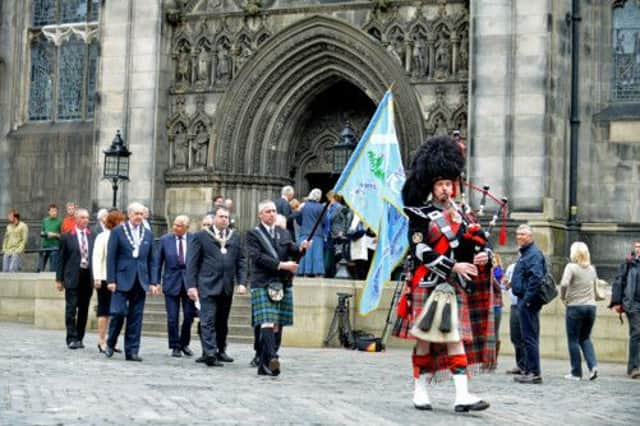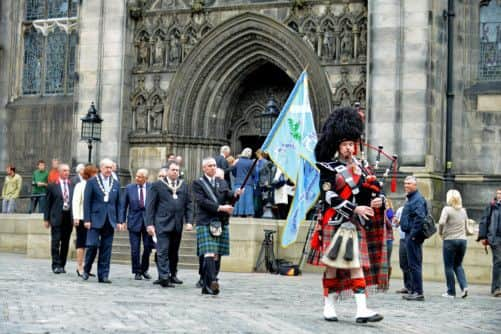Clan chiefs gather to pay respect to Flodden dead


A sleepy, unassuming place, it wears its history lightly, commemorated in the street names such as Flodden Crescent, a tourist information centre that was once a telephone box and a few signs pointing visitors to the site of the battle.
But it was at Flodden memorial, overlooking the town, that a steady stream of visitors came yesterday to pay respects and commemorate the lives thousands of the men, women and children who died here.
Advertisement
Hide AdIt was barely half a mile away that, in the space of two-and-a-half hours on 9 September 1513, some 10,000 Scots soldiers were slaughtered by English troops. Among them was Scotland’s King James IV, the last British monarch to die on the battlfield.


The defeat was to prove a pivotal moment in Scottish history. It wiped out a large part of the country’s political class, saw an end to its status as a European power, and would start the chain of events that led to the creation of the Union.
Tourists travelled from as far as America and South Africa to the site yesterday, as clan societies, re-enacters, political activists and others who wanted to mark the day joined them in climbing the steps to the memorial .
The atmosphere was one of commemoration: voices were lowered, and the loudest sound was a lone piper playing outside a nearby church. But unlike the high-profile run-up to Bannockburn’s anniversary next year, the marking of Flodden’s bloody events have been virtually nonexistent in Scotland. Even on the site, there was little marking the battle yesterday, the exception being a guided tour by local historian Clive Hallam Baker, walking some 300 people through the events of the day.
History student Margaret Ann Fletcher had travelled from Falkirk to pay her respects. The 21-year-old said that the battle had been “brushed under the carpet” because Scotland lost. It deserves, she argued, to be given greater attention.
She said: “It was the 500th anniversary, and I thought, ‘I can’t not come’. It has a real place in our history. It makes me angry that it’s not being spoken about more.”
Advertisement
Hide AdFor Donald Smith, director of the Scottish Storytelling Centre, the lack of a central event commemorating the battle reflected the complex emotions that surround it.
“Scotland never really recovered from this – it is the beginning of the end as an independent country,” he said. “I think it is interesting that so many people have come here for their own reasons of their own volition.”
Advertisement
Hide AdAndy Cannon, a storyteller, agreed. He added: “It seems strange that nobody is marking the moment, not taking a side but simply saying, ‘It’s half a millennium since this happened’.”
James IV’s 30,000-strong army, many armed with unwieldy 18ft pikes, floundered in a bog, and were set upon by the English troops, led Thomas Howard, Earl of Surrey, carrying the lighter and more effective billhooks.
Several days earlier, the Scots had marched into England in support of the French, who had called upon them to fulfil their side of the Auld Alliance, as they were under attack by Henry VIII. Chris Burgess, Flodden archaeological manager, said that despite being “incredibly important”, the battle had “faded into obscurity” until recently.
He added: “The general thrust is to foster remembrance and reconciliation, so I think it’s heading in the right direction. More people know about this now that they have done for the past 200 years. The message is getting out there.”
For Harold Hansen, 70, and son Kevin, 46, both of whom had travelled from Wisconsin in America, the lack of any large- scale event to mark the anniversary seemed strange. But they were moved by the setting itself.
Mr Hansen Snr said: “It’s so shocking that so many died in such a short time, not just on the Scots side but both. It’s a very visceral experience coming here. We had ancestors from the Borders, and it’s likely that some may have died here.”
Advertisement
Hide AdFor Alistair Bowden, a project manager at Flodden said: “Flodden means something down here but it means different things to different communities.”
He said that the decision had been not to pursue a single focused centre, similar to that planned for Bannockburn. Instead, he added, the story of Flodden is being told by lots of people in different ways over time.
Advertisement
Hide AdAs the afternoon wore on Tornado jets screamed overhead while local artist Anna Dakin sat on the ground in front of the memorial, staring at the hill ahead of her, painting an abstract canvas to “try and capture my own feelings about Flodden”.
She had been working on the Flodden archaeological dig: “It’s about making the battle more real so people can relate to it. It’s one of those events that people don’t know very much about, and yet Scotland and England had this incredibly dramatic event.”
Pictures: Jon Savage
SEE ALSO: